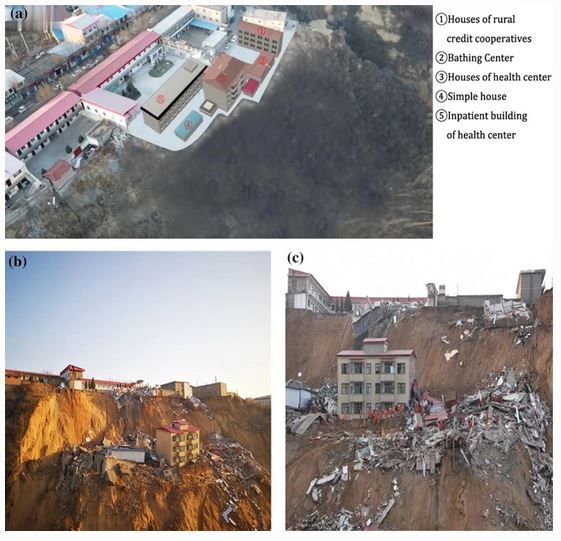15 June 2020
The 15 March 2019 Xiangning landslide in Shanxi Province, China
Posted by Dave Petley
The 15 March 2019 Xiangning landslide in Shanxi Province, China
On 15 March 2019 a large landslide occurred in Xiangning County in Shanxi Province in northern China. The landslide, which occurred in loess, destroyed a number of residential buildings and the local health centre. In total 20 people were killed and a further 13 were injured. A paper has recently been published in Natural Hazards (Zhao and Zhao 2020) that provides some more detail of this disaster.
The authors provide this highly informative montage of photographs and drawing to illustrate the event:-

Schematic montage of images from the 2019 Xiangning landslide in China. Image from Zhao and Zhao (2020).
.
This is quite an unusual loess landslide as it had the form of a slump with limited runout. As the image above shows, the main slump block did not fragment, and one of the larger buildings remained remarkably intact. The landslide had a volume of 73,000 cubic metres and the displaced block was 125 x 80 metres.
Interestingly, Zhao and Zhao (2020) could find no external triggering event, such as an earthquake or intense rainfall. They concluded that the landslide was the result of natural degradation of the loess, perhaps accelerated by human activity such as deforestation.
An unusual aspect of this paper is that it provides some detail about the rescue efforts for the Xiangning landslide:-
Judging from the rescue situation, the on-site rescue environment was highly complicated, challenging, and high risk. First, the landslide had a large volume and deeply buried pressure; those factors considerably influenced the location of rescue site searches. Second, the location of the landslide was on the hillside and caused a complicated situation, while the mountain road was meandering and narrow. Thus, the work surfaces of the rescue operation were small, large machinery could not be used or even come close to the scene, and the efforts of small rescue equipment were limited. Third, the soil of the landslide body was flaccid and the structure was unstable. During the rescue, landslides occurred several times, cracks became larger, and rockfall transpired. Many large building wreckages were scattered on the collapsed mountain; the height from the top to the bottom of the mountain measured dozens of meters, and the slope was almost vertical. The wreckages of the buildings fell off, likely causing harm to the rescuers below who were not evacuated in time.
This is a good illustration of the multiple challenges faced in the aftermath of such disasters.
.
On reflection: The first large landslide disaster of 2020 in Nepal
A large rainfall-induced landslide at Kushma in Durlung, Parbatin Nepal on Saturday night killed nine people. The summer monsoon is becoming active in South Asia.
.
Reference
Zhao, B. and Zhao, Y.Q. 2020. Investigation and analysis of the Xiangning landslide in Shanxi Province, China. Natural Hazards https://doi.org/10.1007/s11069-020-04109-2


 Dave Petley is the Vice-Chancellor of the University of Hull in the United Kingdom. His blog provides commentary and analysis of landslide events occurring worldwide, including the landslides themselves, latest research, and conferences and meetings.
Dave Petley is the Vice-Chancellor of the University of Hull in the United Kingdom. His blog provides commentary and analysis of landslide events occurring worldwide, including the landslides themselves, latest research, and conferences and meetings.